Bulletin – September 2011 The Global Market for Liquefied Natural Gas
- Download the article 243KB
Abstract
Liquefied natural gas (LNG) provides an economic means to transport natural gas over long distances, bringing production from remote gas reserves to market. A large expansion in global LNG trade is currently under way, and Australia is likely to emerge as the second largest supplier globally in coming years. This article describes the functioning of the global LNG market and outlines Australia's position within the market.
Introduction
The global market for LNG is of growing importance to the Australian economy. In recent years, significant investments in LNG production have been committed, with projects under construction currently totalling around A$120 billion. If these projects proceed as planned, Australia's LNG exports are likely to increase more than three-fold over the next five years (see Christie et al 2011).[1] In addition to these committed projects, a number of other developments are being evaluated that could see LNG exports approach coal and iron ore in terms of their contribution to total export earnings over the coming decade.[2]
Natural Gas
Natural gas supplies around one-fifth of the globe's energy needs, compared with one-third from oil and one-quarter from coal (Graph 1). Natural gas has a wide variety of uses with the largest being power generation, followed by industrial uses (such as the production of chemicals) and residential uses (including heating and cooking). In recent decades, there has been strong growth in natural gas consumption in the Asia-Pacific region and the Middle East, although North America remains the largest gas consumer (Graph 2).[3]
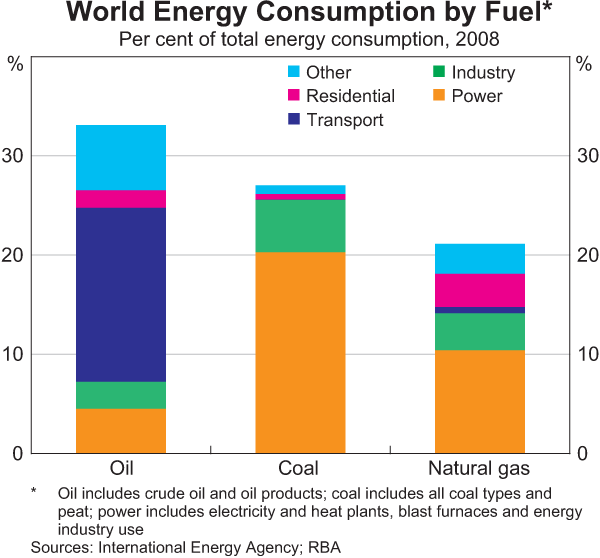
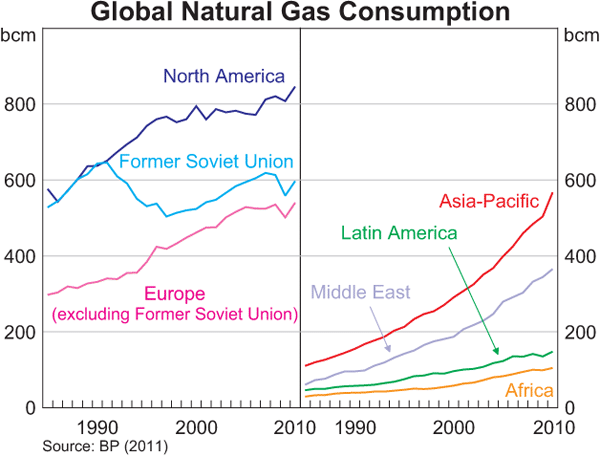
Natural gas is the cleanest-burning fossil fuel, producing significantly lower carbon emissions than coal or oil, as well as lower levels of other pollutants (Table 1). As a result, natural gas has made up a large portion of new electric power generation capacity in recent years, particularly in developed economies where it accounted for nearly three-quarters of capacity growth between 2000 and 2009. The shift toward gas power generation also reflects: lower capital outlays and shorter project lead times compared with coal and nuclear plants; flexibility in providing either peak or base load power or a supplement to intermittent renewable sources; and energy diversification policies.
| Proven reserves 2010 | Production 2010 | Reserves to production ratio | Carbon emissions(b) | |
|---|---|---|---|---|
| Billion tonnes oil equivalent | Billion tonnes oil equivalent per year | Years | Grams CO2 per kilowatt hour | |
| Natural gas | 168 | 2.9 | 59 | 370 |
| Crude oil | 208 | 3.9 | 53 | 640 |
| Coal | 442 | 3.7 | 118 | 720–940 |
|
(a) Oil equivalence is based on average calorific value of different fuels.
Proven reserves are those which, based on geological and engineering information,
can be recovered in future with reasonable certainty based on current
economic and operating conditions. Both conventional and unconventional
sources of gas and oil are included in figures for production and proven
reserves. Sources: BP (2011); International Energy Agency |
||||
Global ‘proven’ reserves of natural gas – that is, known deposits that can be recovered with reasonable certainty given current technology and prices – represent around 60 years of current production (Table 1). Based on energy content, proven gas reserves are around 80 per cent of the size of oil reserves, but only 40 per cent the size of coal reserves.
Proven reserves of gas have increased gradually over time as a result of exploration and improved technology. In recent years, advances in drilling have meant that ‘unconventional’ reserves of gas have become more economic to extract. Unconventional reserves are found in rock formations through which gas does not flow easily so is more difficult to extract – these include coal seam gas, shale gas and tight gas. In Australia, conventional reserves are located primarily off the north-west coast, while significant coal seam gas reserves exist in the eastern coal basins.[4]
The world's total recoverable reserves of gas are likely to be much larger than proven reserves, which are a relatively conservative measure requiring a high degree of certainty. While total recoverable reserves are difficult to measure, the International Energy Agency (IEA) estimates that they equate to around 120 years of current production for conventional deposits, and around 250 years of production including unconventional deposits (IEA 2011b).
Natural Gas Trade and the Role of LNG
As with other energy commodities, reserves of natural gas often do not lie near major centres of demand, resulting in international trade. Around 30 per cent of natural gas produced is internationally traded – much lower than for crude oil, which has around two-thirds of production traded, reflecting the greater difficulties in transporting gas (Graph 3). However, natural gas is traded more than coal, which had only around 15 per cent of production internationally traded in 2010.
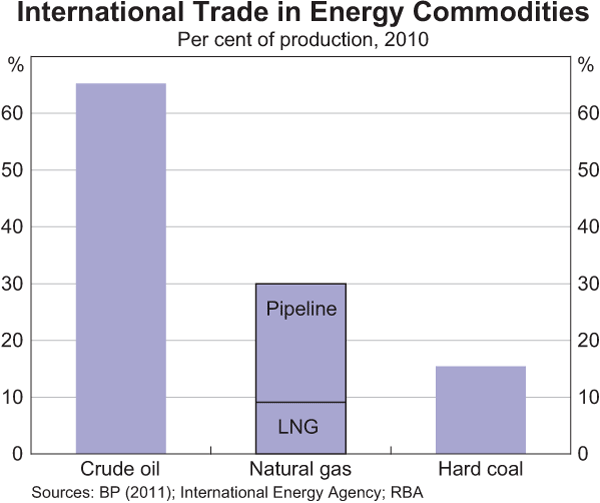
There are two main technologies for transporting and trading natural gas:
- pipelines, where gas is transmitted under high pressure through steel pipes; and
- LNG, where gas is cooled to a liquid at minus 160 degrees Celsius in large ‘trains’, reducing its volume by more than 600 times for transport in specialised tankers.
International pipeline trade is around twice the size of LNG trade. However, LNG is more economic than pipelines over long distances, particularly across oceans. Accordingly, it is used to bring production to market from remote or ‘stranded’ gas fields, provides traditional pipeline customers with alternative supply options from further afield, and is particularly useful in servicing coastal population centres. Reflecting this, LNG accounts for nearly three-quarters of long-distance natural gas trade.[5]
In recent years, LNG has risen substantially as a share of both gas production and trade (Graph 4). Since 2000, global LNG trade has more than doubled while pipeline trade has risen by only around one-third. In part, this reflected falling costs in the 1990s and early 2000s, as technical advances facilitated larger trains and transport tankers.[6] This expansion in LNG trade has been underpinned by large capital investments around the world, with further projects currently under way or being planned (see the section ‘Investment in New Capacity’). As investment has picked up in recent years, costs have risen as projects have competed for skilled labour, become more complex, and taken longer to complete.[7]
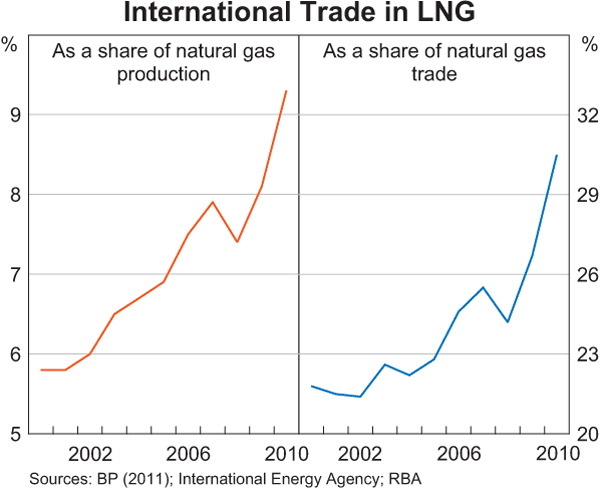
The Structure of the LNG Market
While LNG links buyers with distant reserves, the global market is segmented between the two great ocean basins – the Atlantic and Pacific (Table 2). Because the Middle East is located between the two basins, it exports to both markets. The Asia-Pacific market is larger than the Atlantic market, accounting for a higher share of both imports and exports. However, its share of LNG trade has declined over time, as the Middle East has emerged as a major exporting region and a more diverse group of buyers has emerged in the Atlantic market.
| To: | |||
|---|---|---|---|
| From: | Asia-Pacific | Atlantic | Total |
| Asia-Pacific | 36 | 1 | 37 |
| Middle East | 19 | 14 | 34 |
| Atlantic | 4 | 25 | 29 |
| Total | 60 | 40 | 100 |
|
(a) Asia-Pacific includes Asia, Australasia, Pacific and Russia; Atlantic includes North and South America, Africa, Europe (excluding Russia); Atlantic imports also include the Middle East Source: BP (2011) |
|||
The LNG market developed significantly in the Asia-Pacific in the 1970s and 1980s. This was driven by the major industrial economies in the region at the time – Japan, Korea and Taiwan – seeking to diversify their energy supplies following the surge in oil prices between 1973 and 1980. These economies have little in the way of domestic gas reserves, and are not easily served by pipelines, so they have sought to import gas in the form of LNG. By 1990, Japan alone accounted for two-thirds of global imports, and although this share has since fallen, Japan remains the world's largest importer of LNG by a wide margin (Graph 5). China and India have only recently begun importing LNG, receiving their first shipments in 2006 and 2004, respectively, and each accounts for a relatively small share of world imports. In the Atlantic, a wide group of buyers has developed, including a number of European nations looking to diversify supplies away from pipeline gas, offset declines in local production and secure supply for expanded gas power generation.
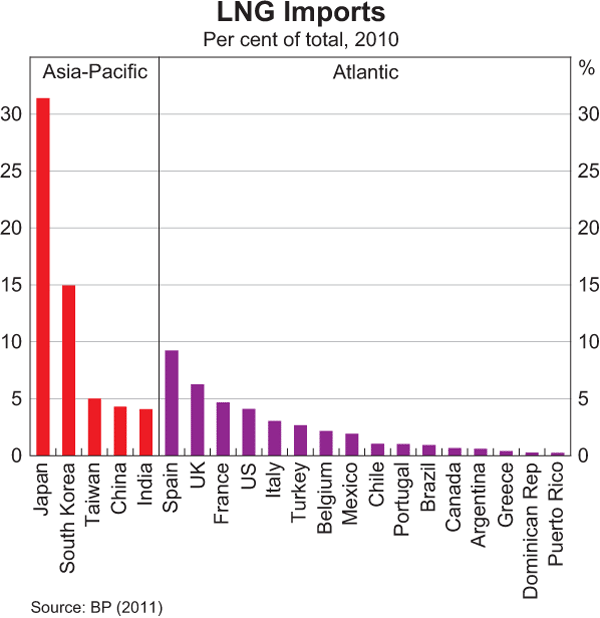
Qatar is the world's largest exporter of LNG, supplying around one-quarter of global exports in 2010 (Graph 6). By comparison, Saudi Arabia – the world's largest crude oil exporter – supplies around 15 per cent of world crude oil exports (IEA 2011a). Qatar has recently completed a major expansion program involving eight new trains and raising the country's export capacity five-fold since 2003, to 105 billion cubic metres (bcm) once the new trains have ramped up to full production. Historically, Qatar primarily served the Asia-Pacific market, but more recently Atlantic buyers have accounted for nearly half of Qatar's exports (Graph 7).
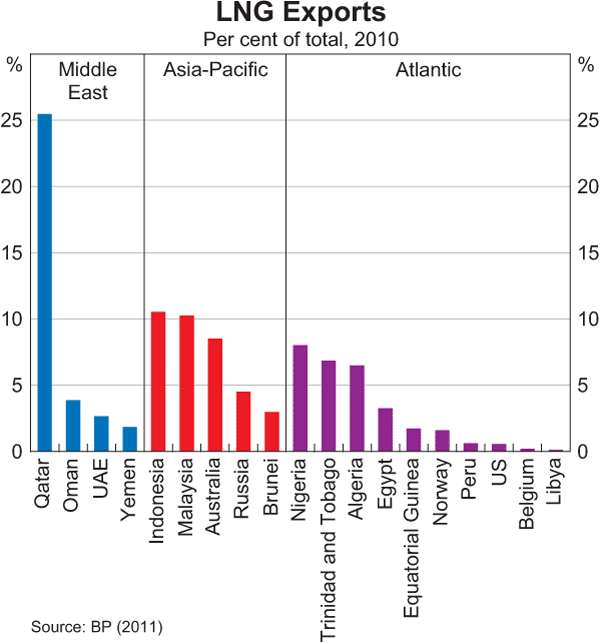
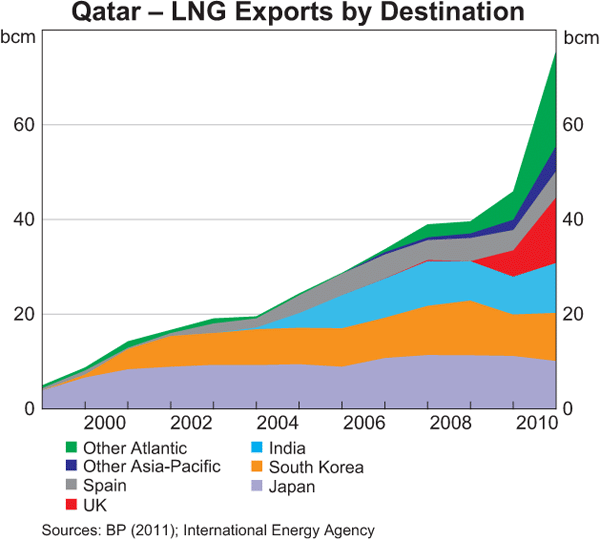
Australia is the fourth largest exporter of LNG, and is the only significant LNG exporter among OECD nations. Australia exports entirely to the Asia-Pacific market, with Japan accounting for almost all of Australia's trade until the early 2000s (Graph 8). Since 2003, major investments have seen Australian exports increase two-and-a-half-fold (see Christie et al 2011), and China has emerged as a major destination. Volumes were also shipped to India for the first time in 2006.
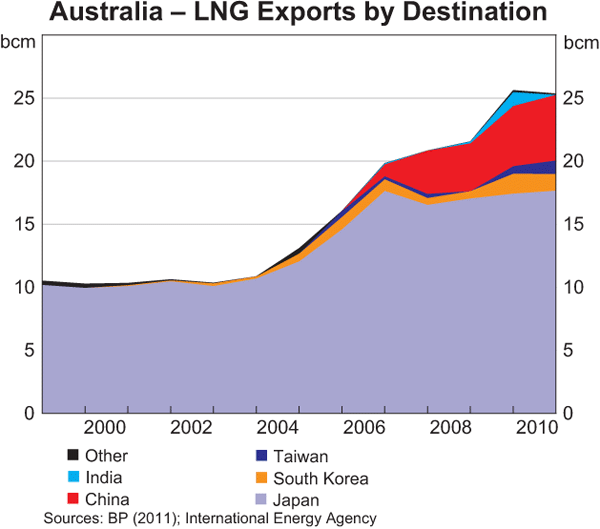
Investment in New Capacity
Rapid growth in LNG production capacity is likely to continue into the future, supported by large capital investments. LNG projects have very long horizons (supply contracts, discussed below, are often for around 20 to 25 years), and so are underpinned by expectations of long-term demand growth. According to the IEA (2010b, 2011b), consumption of natural gas is projected to increase by between 45 and 65 per cent from 2008 to 2035 under the IEA's different scenarios.[8] Particular impetus for increased gas use may come from policy initiatives to reduce dependence on nuclear power following the Fukushima disaster, carbon reduction schemes and the development of unconventional gas.
According to the IEA's projections, the vast bulk of the growth in gas demand is expected to come from non-OECD nations. Particularly rapid growth is expected from China and India, reflecting both increased energy demand and a rise in the share of energy derived from natural gas. In both countries, natural gas currently accounts for a relatively low portion of energy consumption (Graph 9). China has in place a policy objective to roughly double the energy share of natural gas to over 8 per cent by 2015 in order to improve energy efficiency and energy diversification. The use of gas is being promoted by a system of price regulation, and facilitated by major developments of gas supply infrastructure – including pipelines from gas fields in western China and nearby countries, as well as LNG import terminals.
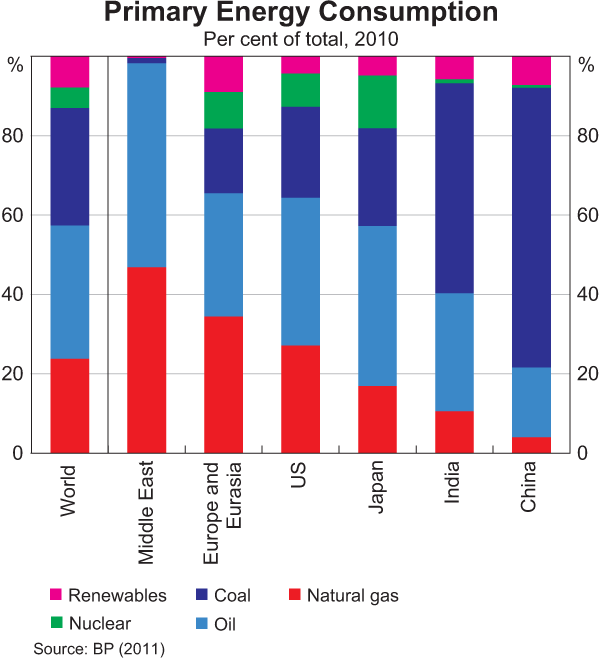
In order to meet increased demand for LNG, significant capital investments are under way or in the planning stages around the world. These are at each level of the supply chain – including gas field development, LNG trains, tanker fleets and import terminals. LNG production and transport is highly capital intensive, so the scale of these investments tends to be very large. Investments in LNG production are largely undertaken by multinational oil and gas companies, in some cases alongside state controlled energy bodies (see IEA 2005).
Australia has emerged as the major centre for investment in LNG production (Graph 10). New capacity equivalent to nearly one-third of global trade is currently under construction, of which around two-thirds is located in Australia.[9] In contrast, Qatar has placed a moratorium on further development of the country's main gas field, reportedly to further assess the productive life of the reservoir (see IEA 2008). If the projects under way proceed as planned, Australia would become the world's second largest LNG exporter in the next few years.
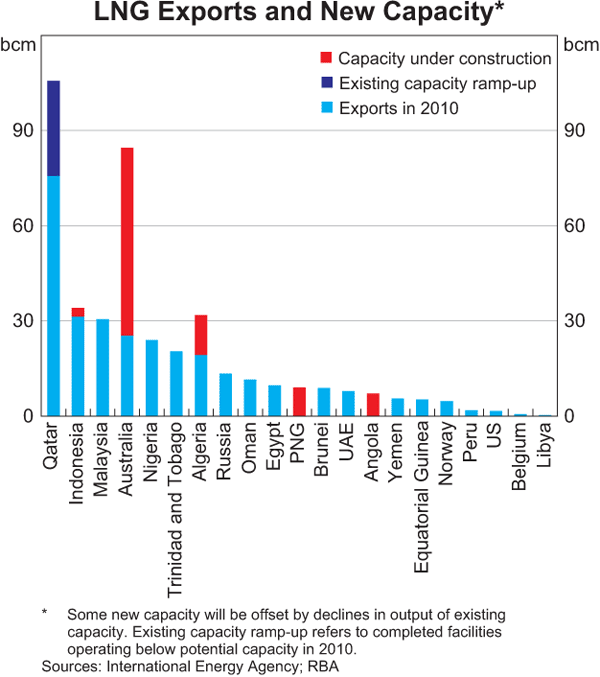
Looking beyond the projects already committed, there is a large group of projects being evaluated around the world. The IEA notes that most of these projects that are likely to reach a final investment decision are based primarily in Australia (IEA 2011b). Those in other regions – particularly Iran, Nigeria and Russia – face greater headwinds including political uncertainty, limited access to LNG technology and large growth in domestic gas demand. While Australia's gas reserves are considerably smaller than these other regions, the nation's overall investment climate is rated as relatively favourable by executives of major petroleum corporations (Graph 11). Australia's proximity to Asia is also a key advantage, particularly given the very high costs of transporting LNG relative to most other commodities.[10]
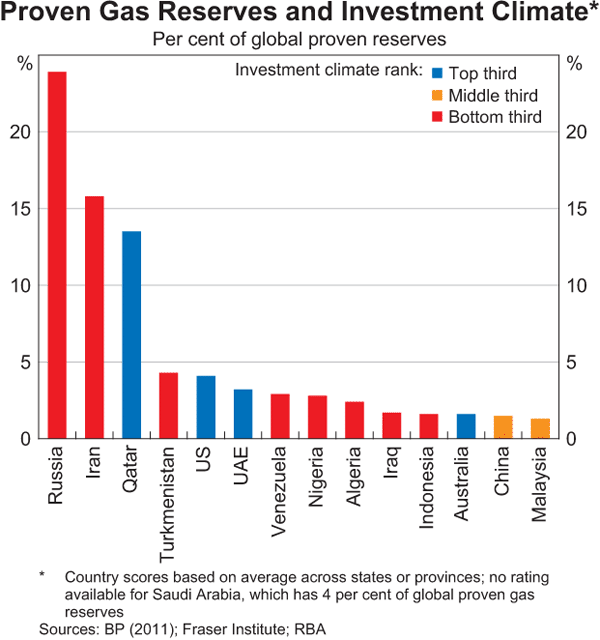
Contractual Arrangements and Pricing
The vast bulk of LNG trade is conducted under long-term supply contracts. Long-term contracts provide buyers with security of energy supply, and producers with certainty when making large scale, long-term investment decisions. Long-term contracts are particularly prevalent in the Asia-Pacific market, accounting for more than 90 per cent of the region's exports in 2010 (Graph 12). Historically, security of supply was particularly important for the traditional LNG importers in the Asia-Pacific – Japan, Korea and Taiwan – as these economies are almost entirely reliant upon LNG imports for their natural gas supply (Graph 13).
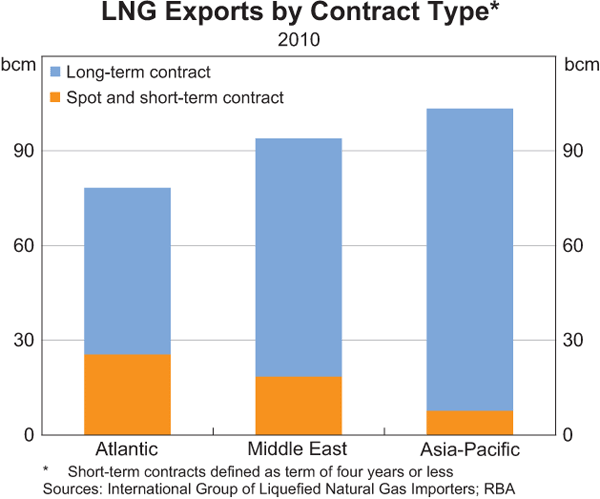
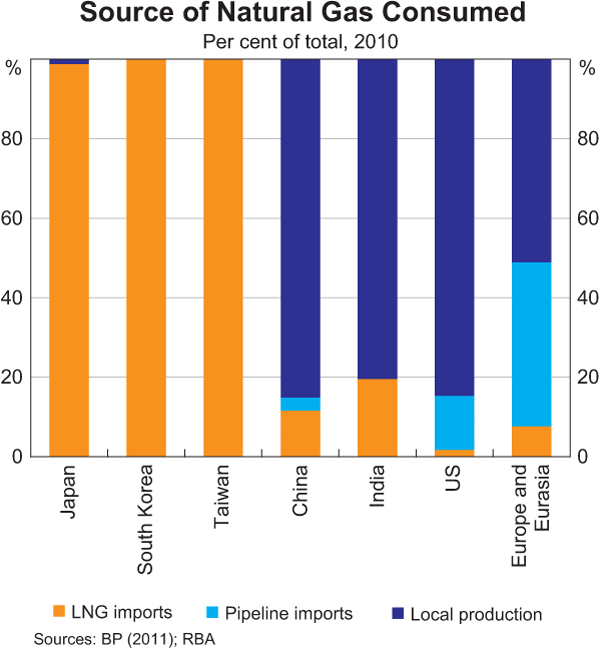
While still dominated by long-term contracts, there has been a gradual shift to more flexible arrangements as the LNG market has grown and become more diverse. Trade on a spot basis and under short-term contracts (of less than four years) has risen from around 5 per cent to 20 per cent of trade over the past decade.[11] In some cases, this reflects projects electing not to sell their entire output under contract in advance due to production uncertainty, and selling any above-contract output on the spot market. Spot and short-term trade has been relatively prevalent in the Atlantic market, accounting for one-third of trade in 2010. Among Atlantic importers, LNG is small relative to pipeline trade and local gas production, and has to compete with these alternative gas supplies. Spot trade also accounts for a large portion of inter-basin LNG trade, with cargoes in recent years tending to flow from Atlantic producers to Asia-Pacific buyers.
Prices under long-term contracts are based on formulas linked to a reference rate – usually the lagged price of crude oil. Accordingly, the price per unit of LNG increases (decreases) when spot price of crude oil rises (falls), usually with a set lag of a few months. However, because these contracts are privately negotiated the exact formulas are not publicly available. Across Asia, LNG contract prices are typically linked to the Japan Customs-cleared Crude price (JCC). Historically, it has been common for contracts to have formulas that are non-linear, incorporating an ‘S-curve’ that moderates the impact of both high and low oil prices upon the LNG price.[12]
In contrast, spot LNG prices tend to track natural gas market fundamentals more closely. Spot prices are most easily observed at major gas trading hubs, where competing sources of gas (both pipeline and LNG) are priced. Of particular note are the Henry Hub in the southern United States, and the National Balancing Point in the United Kingdom (which is not actually a physical location). These hubs act as the pricing and delivery points for natural gas futures contracts.
Because of the diversity in pricing arrangements, the segmented nature of the global market, and differences in gas quality, prevailing LNG prices can vary significantly around the world (Graph 14). While only limited data are available, the highest reported LNG import price in 2010 was around three times the lowest reported price (on an annual average basis).[13] In contrast, there is much less variation in crude oil prices across the world.
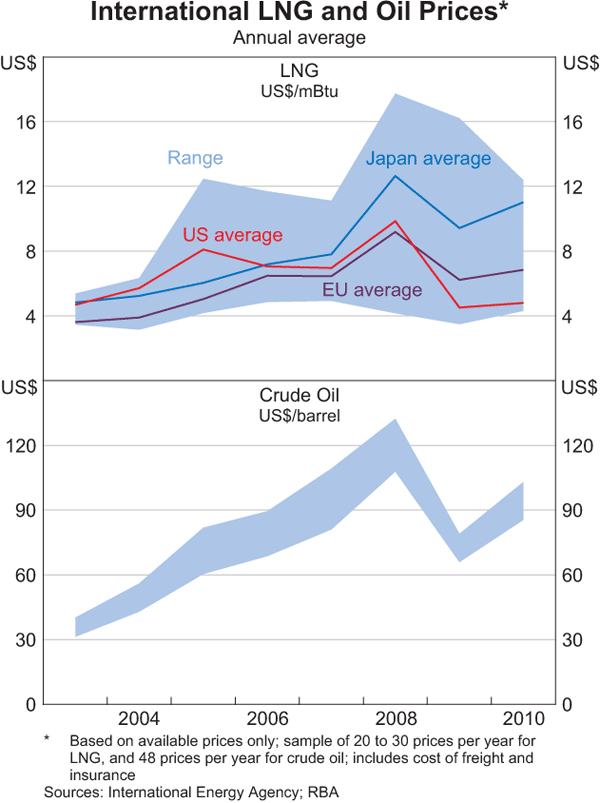
LNG prices have become more dispersed in recent years. This has been due primarily to different supply and demand developments across regions, and between the gas and oil markets. After falling during the global recession, oil-linked contract prices in the Asia-Pacific have risen as a result of higher oil prices; the average cost of Japanese LNG imports from Australia has doubled since its trough in 2009 (Graph 15).[14] However, spot gas prices in the Atlantic have remained relatively subdued, particularly in North America, with the Henry Hub spot price having risen little since 2009. The low level of US spot prices has reflected large growth in unconventional gas production, as well as weak energy demand.

Risks to the Outlook
While large-scale investments in LNG are under way, these projects are subject to a number of risks, both prior to and after completion. These risks include competing sources of gas supply, escalating costs in the investment stage and changes in global oil prices.
Unconventional gas production has already had a considerable impact upon the LNG market, and could further affect the global gas supply if developed more widely. In the United States, increased unconventional production has resulted in a large fall in expected LNG import demand, and been a major factor in the low level of US spot gas prices. Since 2005, shale gas has risen from 4 per cent to 23 per cent of US gas production, and is expected to reach one-third by the middle of the decade (EIA 2011a, 2011b). This has substantially altered the nation's supply-demand balance; the United States was previously expected to become a major LNG importer, as reflected in Energy Information Administration forecasts at the time (Graph 16). However, the nation is now largely gas self-sufficient and there are some proposals to export LNG, potentially to the Asia-Pacific market.
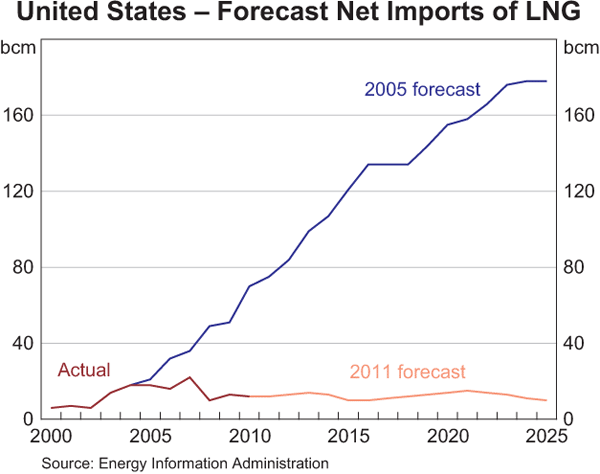
To date the development of unconventional gas has been primarily in the United States and Canada, but deposits are abundant around the world (Graph 17). A number of regions have taken steps in recent years to increase unconventional production, including some of Australia's major export markets (IEA 2010a). In China, large reserves of both shale and coal seam gas are believed to exist, and there have recently been various steps towards exploration and development of these reserves. Australia currently produces small volumes of unconventional natural gas, although projects under way in Queensland will see coal seam gas used to supply LNG for the first time.
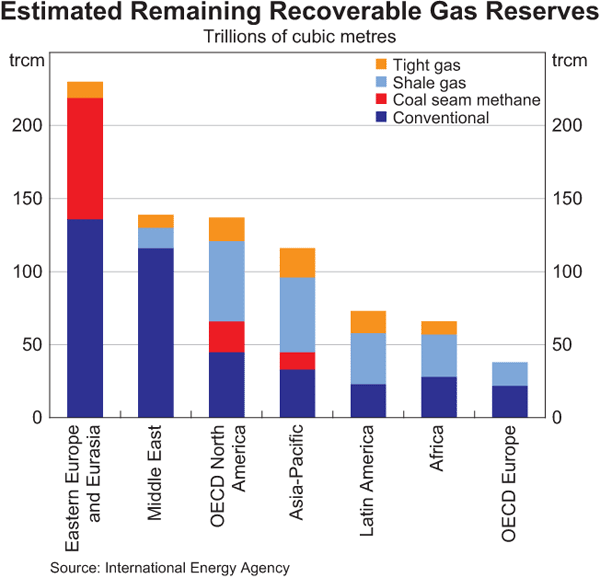
While unconventional gas has the potential to provide a major source of new supply globally, possibly displacing some LNG imports, there are also barriers to its further development. The methods used to extract unconventional gas have come under scrutiny in recent years, particularly with regard to their potential impact on the environment. Concerns have been raised regarding the possible contamination of groundwater from the main technique used to extract unconventional gas, which involves fracturing rock deposits by pumping fluids under high pressure. In some cases around the world, the quality of gas is also thought to be low compared with the high-grade gas used to produce Australian LNG. Aside from environmental issues, it may also take some time to bring new production to market.
An additional risk to Asia-Pacific LNG producers is the potential for Qatar to redirect production. According to industry analysts, a significant volume of Qatar's LNG output could potentially be diverted from the Atlantic market to the Asia-Pacific market (see, for example, Wood Mackenzie (2011)). However, Qatar is reportedly seeking pricing terms that some Asia-Pacific buyers have to date been unwilling to accept.
While LNG investments face a variety of risks, the use of long-term contracts affords a significant degree of protection, particularly in terms of volumes. In Australia, projects typically do not proceed until sales contracts are in place. Australia also remains a favoured contract partner owing to a low level of geopolitical risk. Thus, although the LNG market might look substantially different down the track, projects that are currently well advanced and can get product to market quickly will have an advantage in securing long-term supply contracts. Australian projects are well placed in this regard, as LNG investments have already progressed significantly with a number of projects receiving final investment approval in 2011, and more are expected over the period ahead.
Conclusion
Natural gas is a key source of energy for the world economy. An increasing share of natural gas is traded by way of LNG, which facilitates long-distance trade and brings gas from remote reserves to market. The LNG market is not as globalised as some other energy commodities, with trade segmented between regions and subject to a variety of pricing arrangements. Over coming decades, demand for LNG is expected to grow rapidly in the Asia-Pacific. In response, Australia has emerged as a major centre for LNG investment and is likely to become the second largest LNG supplier globally during the decade. As a result, developments in the LNG market have taken on increased importance for the Australian economy.
Footnotes
The author is from Domestic Markets Department, and formerly from Economic Analysis Department, and would like to thank Virginia Christie for her valuable contributions. [*]
These figures are based on projects that have received final investment approval: Australia Pacific LNG (phase 1), Gladstone LNG, Gorgon LNG, Pluto Foundation Project, Prelude FLNG and Queensland Curtis LNG. Some projects have received approval since Christie et al (2011). [1]
The global market for bulk commodities has been discussed previously in Christie et al (2011) and Andrews (2009). [2]
A variety of measurement units are commonly used for natural gas and LNG. This article uses billions of cubic metres (bcm) except where otherwise indicated, consistent with the practice of the International Energy Agency. For conversion tables, see BP (2011). [3]
See Geoscience Australia and ABARE (2010). While coal seam gas currently accounts for a small portion of Australia's economic demonstrated reserves, total identified and potential coal seam reserves are substantially larger and may exceed conventional reserves. [4]
Long-distance trade is defined as between continents or geographic regions. [5]
The capital cost of LNG train capacity roughly halved between 1990 and 2004 (IEA 2005). [6]
See Geoscience Australia and ABARE (2010) and IEA (2008, 2009). [7]
Based on the following three IEA scenarios: current energy policies; incorporating broad energy policy commitments already made to address climate change and energy security; and including policy commitments but where gas plays a particularly prominent role in meeting future energy needs. [8]
Based on data from IEA (2011b), as well as Australian projects receiving final investment approval after the publication of IEA (2011b). [9]
While Australia's proven reserves are smaller than other regions, unproven reserves are also significant. According to Geoscience Australia and ABARE (2010), overall gas reserves are sufficient to support a large increase in production. [10]
According to GIIGNL (2010) and IGU (2010). [11]
Jensen (2011) notes that S-curves have become less prevalent in recent years. [12]
Jensen (2011) discusses arbitrage in the LNG market. [13]
Around 97 per cent of Australian exports to Japan in 2010 were under long-term contracts, according to GIIGNL (2010). [14]
References
Andrews D (2009), ‘Australia and the Global Market for Bulk Commodities’, RBA Bulletin, January, pp 1–6.
BP (2011), BP Statistical Review of World Energy, June 2011, BP plc, London.
Christie V, B Mitchell, D Orsmond and M Van Zyl (2011), ‘The Iron Ore, Coal and Gas Sectors’, RBA Bulletin, March, pp 1–7.
EIA (Energy Information Administration) (2011a), Annual Energy Outlook 2011, US Department of Energy, Washington DC.
EIA (2011b), World Shale Gas Resources: An Initial Assessment of 14 Regions Outside the United States, US Department of Energy, Washington DC.
Geoscience Australia and ABARE (2010),Australian Energy Resource Assessment, Canberra.
GIIGNL (International Group of Liquefied Natural Gas Importers) (2010), The LNG Industry 2010, Paris.
IEA (International Energy Agency) (2005), Resources to Reserves: Oil & Gas Technologies for the Energy Markets of the Future, OECD/IEA, Paris.
IEA (2008), Natural Gas Market Review 2008, OECD/IEA, Paris
IEA (2009), Natural Gas Market Review 2009, OECD/IEA, Paris.
IEA (2010a), Medium-Term Oil & Gas Markets 2010, OECD/IEA, Paris.
IEA (2010b),World Energy Outlook 2010, OECD/IEA, Paris.
IEA (2011a), Oil Information 2011, OECD/IEA, Paris.
IEA (2011b),World Energy Outlook 2011 Special Report: Are We Entering a Golden Age of Gas?, OECD/IEA, Paris.
IGU(International Gas Union) (2010),World LNG Report, Oslo.
Jensen JT (2011),‘Asian Natural Gas Markets: Supply, Infrastructure, and Pricing Issues,’ Paper presented at the 2011 Pacific Energy Summit, ‘Unlocking the Potential of Natural Gas in the Asia Pacific’, Jakarta, 21–23 February.
Wood Mackenzie (2011), ‘Pacific Basin LNG – How Will the Market be Balanced’, Paper presented at the Wood MacKenzie Global Gas and LNG Forum, ‘Factors Shaping Asia-Pacific's Future', Tokyo/Singapore, 17/24 May.